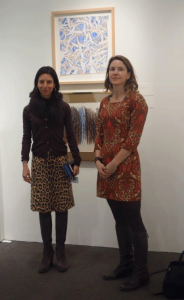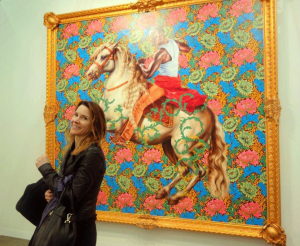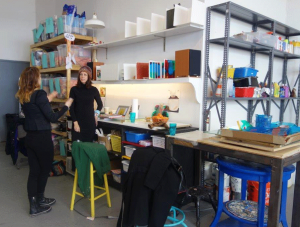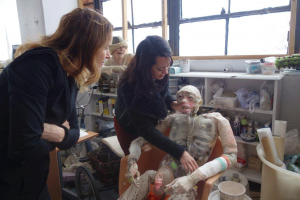By MMoA Deputy Director for Public Engagement and Operations, Dawn Salerno
 Between March 2 and 4, I visited New York City to sample the contemporary art scene. My travels took me to artists’ studios, an auction house, and the well-known international Armory Show art fair.
Between March 2 and 4, I visited New York City to sample the contemporary art scene. My travels took me to artists’ studios, an auction house, and the well-known international Armory Show art fair.
My first stop: Sotheby’s, where I had the privilege of meeting Nina Del Rio, the Senior Vice President, and Head of Department for Museum Services. That title means, among other things, that she is the contact for museums when they get to the point of selling an artwork. She was currently in training to be an auctioneer as well, so look for her at this auction house’s podium in the near future. Del Rio gave me a behind-the-scenes tour of Contemporary Curated just as it had closed. Sotheby’s called this auction “the foremost destination for new collectors and established clients to acquire accessibly priced works by leading artists of the postwar and contemporary periods.” Highlights included works by Sam Francis, Ken Price, Andy Warhol, Josef Albers and Joan Mitchell, among others.
Thursday was Armory day – my first art fair, but well-known to any contemporary curator, collector or museum director. Anyone with an interest in art and art museums would enjoy a day at an art fair. They exist for totally different purposes, of course, but the installations are professional and the variety of artwork ensures you will see something of personal interest. And then there’s the champagne bar! Armory is known for international contemporary and modern art. These works have just entered the art market, in many cases, and some will soon become the property of a collector or museum.
I was not surprised, after seeing his work in person, that artist Kehinde Wiley was a best seller at Armory. Wiley’s life-size portraits set against tapestry like backgrounds and finished within garish frames are visual magnets.  You too could own a Wiley for a mere $300,000. I noticed a trend towards woven works made to look like other media, some resembling Mark Rothko’s color field paintings, and others appearing like drawings of interlaced spider-webs. I found the fair no more exhausting than a day at the museum: in other words, it was exhausting. But the periodic stations for coffee and the scattering of art fair fashionistas kept me rounding the next corridor for more.
You too could own a Wiley for a mere $300,000. I noticed a trend towards woven works made to look like other media, some resembling Mark Rothko’s color field paintings, and others appearing like drawings of interlaced spider-webs. I found the fair no more exhausting than a day at the museum: in other words, it was exhausting. But the periodic stations for coffee and the scattering of art fair fashionistas kept me rounding the next corridor for more.
 On Friday, a brief subway ride delivered me to two studio visits in Brooklyn: those of Summer Wheat and Monica Cook. The former had just come back from Oklahoma City where she has a solo exhibition. She toured me through the work of that exhibition as she discussed her thought process and inspiration. Wheat says she “searches history from a material and conceptual point of view”. She has recently been inspired by Johannes Vermeer’s The Milkmaid. “I look inside the space of the painting and ask questions about what is hidden from the viewer….I reinvent this painted character by building installations of her domestic spaces, each exhibit part of an evolving parafictional world.” Wheat’s media is varied, from paintings to sculpture and her own innovative medium of “tapestries”, made by pushing acrylic paint through window screening. Cook also works in all media, but her latest focus is on animation of her own hand-built sculptures. This was the type of studio which revealed the intricacies of the art-making process. Lying around Cook’s worktable was everything from vintage Busch beer wall sconces (yes, wall sconces), to partial skeletons of various animals. All would contribute to her upcoming installation. Both Wheat and Cook had attended art fairs and preview parties this past New York art fair week. Both had also dealt with gallery agents and agreed that the best kind of gallery representation nurtures the artist’s creative process, helping them to answer their own questions about the art as it emerges from the ether. You would not hear that type of gallerist saying, “don’t do that because I can’t sell that”.
On Friday, a brief subway ride delivered me to two studio visits in Brooklyn: those of Summer Wheat and Monica Cook. The former had just come back from Oklahoma City where she has a solo exhibition. She toured me through the work of that exhibition as she discussed her thought process and inspiration. Wheat says she “searches history from a material and conceptual point of view”. She has recently been inspired by Johannes Vermeer’s The Milkmaid. “I look inside the space of the painting and ask questions about what is hidden from the viewer….I reinvent this painted character by building installations of her domestic spaces, each exhibit part of an evolving parafictional world.” Wheat’s media is varied, from paintings to sculpture and her own innovative medium of “tapestries”, made by pushing acrylic paint through window screening. Cook also works in all media, but her latest focus is on animation of her own hand-built sculptures. This was the type of studio which revealed the intricacies of the art-making process. Lying around Cook’s worktable was everything from vintage Busch beer wall sconces (yes, wall sconces), to partial skeletons of various animals. All would contribute to her upcoming installation. Both Wheat and Cook had attended art fairs and preview parties this past New York art fair week. Both had also dealt with gallery agents and agreed that the best kind of gallery representation nurtures the artist’s creative process, helping them to answer their own questions about the art as it emerges from the ether. You would not hear that type of gallerist saying, “don’t do that because I can’t sell that”.
Lunch with both artists was equally entertaining and happened at a local favorite taco bar, the Tortilleria Mexicana Los Hermanos (read, “go to this place if you’re ever in Brooklyn!) Our conversation over our freshly-made taco meal is what tied all of my New York experiences together. After all, these two young artists were the creators of the st uff commodified by events like the Amory Show or art house auctions. From another lens, the fair and auction were sustaining these artists and helping share their art with the rest of the world. I had, in my New York travels these three days, witnessed artwork in its lifecycle, from the generative stage of the studio, to the resale market of auction house. Like the tortilla factory turned taco bar, art would inevitably travel from maker to market.
uff commodified by events like the Amory Show or art house auctions. From another lens, the fair and auction were sustaining these artists and helping share their art with the rest of the world. I had, in my New York travels these three days, witnessed artwork in its lifecycle, from the generative stage of the studio, to the resale market of auction house. Like the tortilla factory turned taco bar, art would inevitably travel from maker to market.

